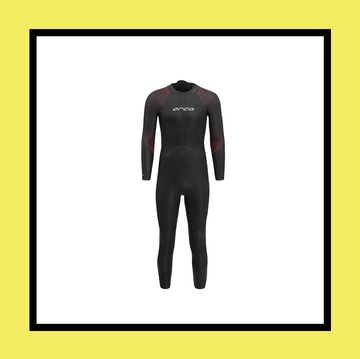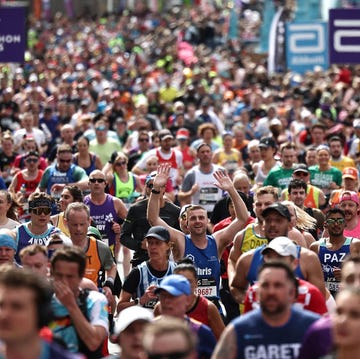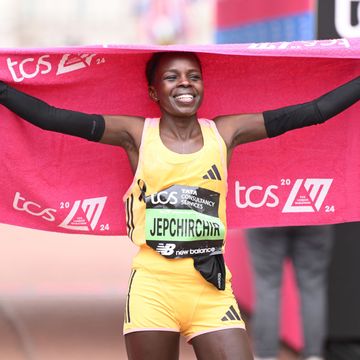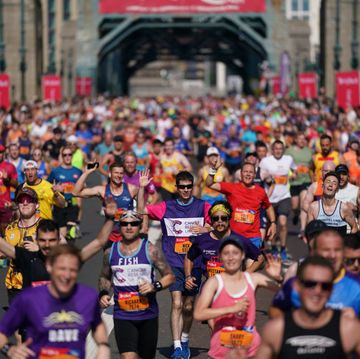Threshold work is one of the cornerstones of training for runners who are tackling distances from 800m to ultras. Your lactate threshold is the point at which lactate is produced and accumulates in the blood at a faster rate than it can be removed, which leads to fatigue. Threshold training is designed to raise this point, enabling you to run faster for longer.
When we exercise, we break down glucose to create energy. Lactate and hydrogen ions are produced as a part of this process and enter the bloodstream. At slower paces, your body clears these by-products (known as buffering) with ease and uses lactate as an energy source. As you run harder, these by-products increase in your blood above their baseline – this is called lactate threshold.
Lactate is generally measured in millimoles per litre (mmol/L) and lactate threshold usually occurs around 2mmol/L. If you continue to increase running intensity, your body’s ability to clear and reuse lactate can’t keep pace with the rate at which it’s being produced – this is your lactate turn point. Beyond this, hydrogen ions and lactate rapidly increase in your blood. The increase in hydrogen ions lowers the pH level of your blood, making it more acidic. This reduces your muscles’ ability to contract, slowing you down. This point often occurs around 4mmol/L of lactate. So while lactate itself does not cause fatigue, we can use it as a proxy measurement for the other changes taking place that do limit your performance.
How to determine your lactate turnpoint
There are various physiological lab and field tests that can help determine your threshold and turnpoint. These involve running a series of efforts that gradually increase in intensity, with a finger or ear prick of blood taken at the end of each effort. As your lactate levels rise, they can be cross-matched with your pace, heart rate (HR) and rate of perceived exertion to give your thresholds with a reasonable degree of accuracy. However, this can be expensive.
Many running watches can estimate your lactate turnpoint, but the accuracy of such measurements should be trusted only if they correlate with the results of other methods. For example, you can conduct your own maximum heart-rate test and then estimate your lactate turnpoint to occur somewhere in the range of 86% to 90% of this figure. Run a race that will take your roughly an hour. Provided you are ready to run at your maximum intensity and you pace it well, you can get a decent estimate of pace, HR and perceived effort to use in your threshold sessions.
You can also go by feel. Controlled discomfort is a good way to think of running a turnpoint – 7 to 8 out of 10, or a level at which you could still speak two or three words. Yes, it's less accurate, but it's a starting point and it gets you in the ballpark – sometimes we can be too caught up in the numbers, and not enough in the feel of the run.
How does threshold training improve performance?
Many coaches, physiologists and athletes believe training just below, on or above your lactate turnpoint is a key way to improve it. Famous examples are Paula Radcliffe and Norway’s Ingebrigtsen brothers. This involves running a range of paces that fall between your lactate threshold (from around marathon pace) up to just beyond your lactate turnpoint (up to about 10K pace).
However, some coaches and athletes eschew the threshold model of training in favour of other approaches. You may be familiar with the concept of polarised training, where a high percentage of training (up to 80%) is spent at low intensities, with the rest run at the lactate turnpoint or above, steering clear of the middle ground that much of threshold training can fall into.
What works for you must be based on your individual training history and circumstances, but I have found threshold-based training has helped many of the athletes I’ve coached over the past 12 years. It’s not a magic bullet, and it needs to be mixed with good recovery and a broader sensible training mix, but if you aren’t including threshold work in your sessions, you could be missing out on some iimportant development as a runner.
Is tempo pace the same as threshold pace?
Terminology in running can be confusing. If you're wondering about the differences between threshold and tempo running, I'm afraid I can't give a straight answer. For some runner and coaches, tempo running refers to longer efforts at a slightly lower intensity, which you might be able to hold for two to three hours in a race (closer to lactate threshold).
For others, it's a run at a pace slightly stronger than lactate turnpoint, closer to 30 to 40-minute race pace, while some use tempo running and threshold running interchangeably.
Sometimes, it's better to just say what you mean: for example, run for a pace you could hold for 40 to 60 minutes in a race, run at this heart rate, ect. Or can you make it even simpler – easy, steady, strong, hard, for example.
Try these 3 threshold workouts
How do you do them then?
Train for extended periods at, or close to, your lactate turnpoint.
What intensity?
Run at a pace you feel you could hold for 50 to 60 minutes in a race. Most runners’ heart rates would be at 86 to 90% of their maximum at this effort.
What volume?
If you’re just starting out or racing over shorter distances (1500m to 5K), then 15 to 25 minutes at this effort is enough. For half-marathon or marathon training, consider building to 30 to 50 minutes of effort as you get closer to race day.
1/ STRAIGHT THRESHOLD
Warm up well and include 15 to 25 mins of running at threshold effort before cooling down.
Spice it up: When you’re in top condition, add a 30 to 60-sec surge up to 5 to 10K pace every five minutes to improve your ability to buffer lactate.
2/ PROGRESSION RUNS
Start easy and build gradually to include a block of threshold running towards the latter stages of a continuous run. For example, 15 mins easy, 15 steady and 15 at threshold effort.
Spice it up: Pick a flat or rolling route and run out for 22 mins, building to a steady effort. Run the same route back, aiming to finish in 40 mins.
3/ SPLIT THRESHOLD
Splitting threshold sessions into long efforts with short, easy or steady recoveries can allow you to extend the amount of time you spend at threshold effort, or run slightly quicker while keeping your intensity under control. For example, 6 x 5 mins with 60-sec easy recoveries, or 3 x 10-15 mins with 2-min easy-to-steady recoveries.
Spice it up: Split sessions allow you to vary your paces. Try 12 mins, 10 mins, 8 mins and 4 mins, with 90-sec recoveries. Start at a pace you could hold for 60 to 70 mins in a race and work down to 30 to 45-min race pace.













